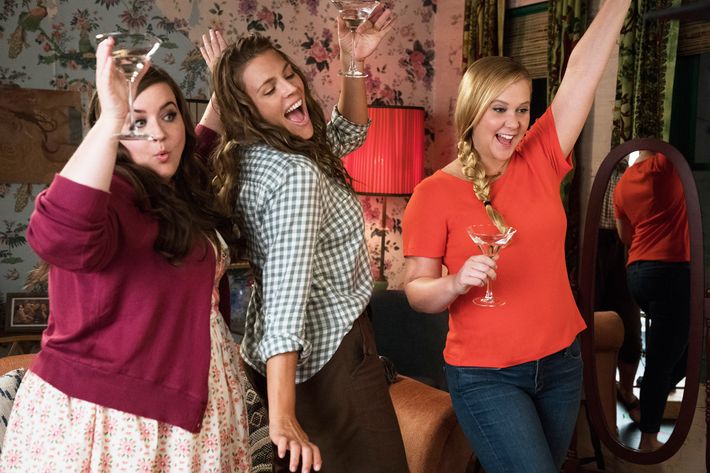
Most of the memorable moments in the recent sex farce Blockers are the big cartoonish ones, which you might expect from a movie that gives us John Cena chugging beer through his anus. But there’s also one quiet moment I can’t stop thinking about. Early in the movie, a character played by Hannibal Buress reassures his teenage step-daughter that prom is a night where friends deepen their bonds. For instance, at his own prom, he and his buddies convinced one guy to join the Army — and that friend was immediately killed in the Gulf War.
It’s a funny bit, but even in the moment, I couldn’t help but wonder, Wait, how old was Hannibal Buress during the Gulf War? So I Googled it: Hannibal Buress was born on February 4, 1983, which means in real life he was in somewhere near the second grade during Operation Desert Storm. Now, you might argue that Buress’s character could have been talking about the 2003 invasion of Iraq, which Wikipedia says is sometimes also called the Gulf War, to which I say (1) no one calls the Iraq War “the Gulf War,” and (2) that would ruin the point of this post, which is about my favorite weird movie trope: comedies that get actors of wildly different ages to play childhood friends.
Take the recent I Feel Pretty, a star vehicle for Amy Schumer (June 1, 1981). Schumer’s character has two lifelong friends, and the three of them share the interests and cultural references of people born on the Gen-X/millennial border, which in this case means they all have matching tattoos of 90210’s Andrea Zuckerman. One of the friends is played by Busy Phillips (June 25, 1979), which checks out, but the other one is played by Aidy Bryant (May 7, 1987), who was all of eight years old when Gabrielle Carteris decided to leave 90210. The whole movie I kept waiting for someone to bring up the fact that one of the friends was six-to-eight years younger than the other two, but for some reason the filmmakers decided to address boring things like “plot” and “themes” instead.

Once you start thinking about this thing, you notice it everywhere. You see it in minor examples like the recent Most Likely to Murder, where Adam Pally (March 18, 1982), Rachel Bloom (April 3, 1987), and Vincent Kartheiser (May 5, 1979) all play former high-school classmates. You see it in Girls Trip, where Tiffany Haddish (December 3, 1979) was supposed to be college besties with three actresses born in the early ‘70s. And you especially see it in films about middle-aged men reconnecting with their high-school sweethearts, who thanks to the magic of the movies are often played by women nearly a decade their junior. My favorite example is This Is Where I Leave You, which imagined a world where Jason Bateman (January 14, 1969) and Rose Byrne (July 24, 1979) were old school chums. Playing a character nearly a decade younger than he really is happens to Bateman a lot — This Is Where I Leave You also gave us Corey Stoll (March 14, 1976) as his older brother, and in The Change-Up, his best friend since elementary school was played by Ryan Reynolds (October 23, 1976). (It even extends outside comedies; in the thriller The Gift, Bateman’s high-school classmate was played by the five-years-younger Joel Edgerton.) It’s like he’s been frozen in time as season-two Michael Bluth.
Why do I love it when this happens? First, because it’s silly. (Dramas don’t usually have this problem, though I get a kick out of imagining a version of Mystic River that replaced Tim Robbins with Matthew McConaughey.) And second, because it seems incredibly easy to avoid — just say that the characters met at work, or at a bar, or while playing D&D, or at one of the many other places where you can meet and befriend people who are a different age from you. But no. Hollywood keeps on insisting that these actors grew up together, even while their hairlines tell a different story.
Which is why I’m excited for the upcoming Tag, which takes this trope to its most absurd lengths yet. The film follows a group of friends who, the trailer informs us, have “been playing the same game of tag for 30 years.” These friends are played by:
• Jeremy Renner (January 7, 1971)
• Jon Hamm (March 10, 1971)
(Checks out, although I don’t know if anyone necessarily would have expected Hawkeye to be older than Don Draper.)
• Ed Helms (January 24, 1974)
(Still pretty normal.)
• Jake Johnson (May 28, 1978)
(Getting weirder …)
• Hannibal Buress again! (February 4, 1983, if you forgot.)
Taking the 30-year line at face value, this movie is about a game of tag that was originally played by two 17-year-olds, a 14-year-old, a 10-year-old, and a 5-year-old. In other words, madness.
So, why is this happening? I’m sure most of it is comedies casting for chemistry rather than realism. (Tag has been in development for a while, first with similarly aged stars Will Ferrell and Jack Black, and later the 49-year-old Tracy Morgan was part of the ensemble. You’ve got to figure that eventually the filmmakers just threw up their hands and brought in any actor who looked older than 30.) But you’ll also notice that, in many cases, the older actors in each movie are also the more famous ones. It’s the vanity sizing of casting — surrounding your 40-something star with childhood friends in their 30s is a good way to signal to the audience that he’s still got it.
But if you want to go full galaxy-brain, consider this: With the collapse of traditional markers of adulthood, our vision of what it means to be a grown-up has likewise become so murky that, in pop culture at least, there’s really not much difference between a 33-year-old and a 47-year-old anymore. Both of them might be getting married, caring for a newborn, saving up for a house, or yes, playing a game of tag with their middle-school buddies.
Or maybe it’s just that Hannibal Buress is a really good auditioner. Yes, I think that’s it.


